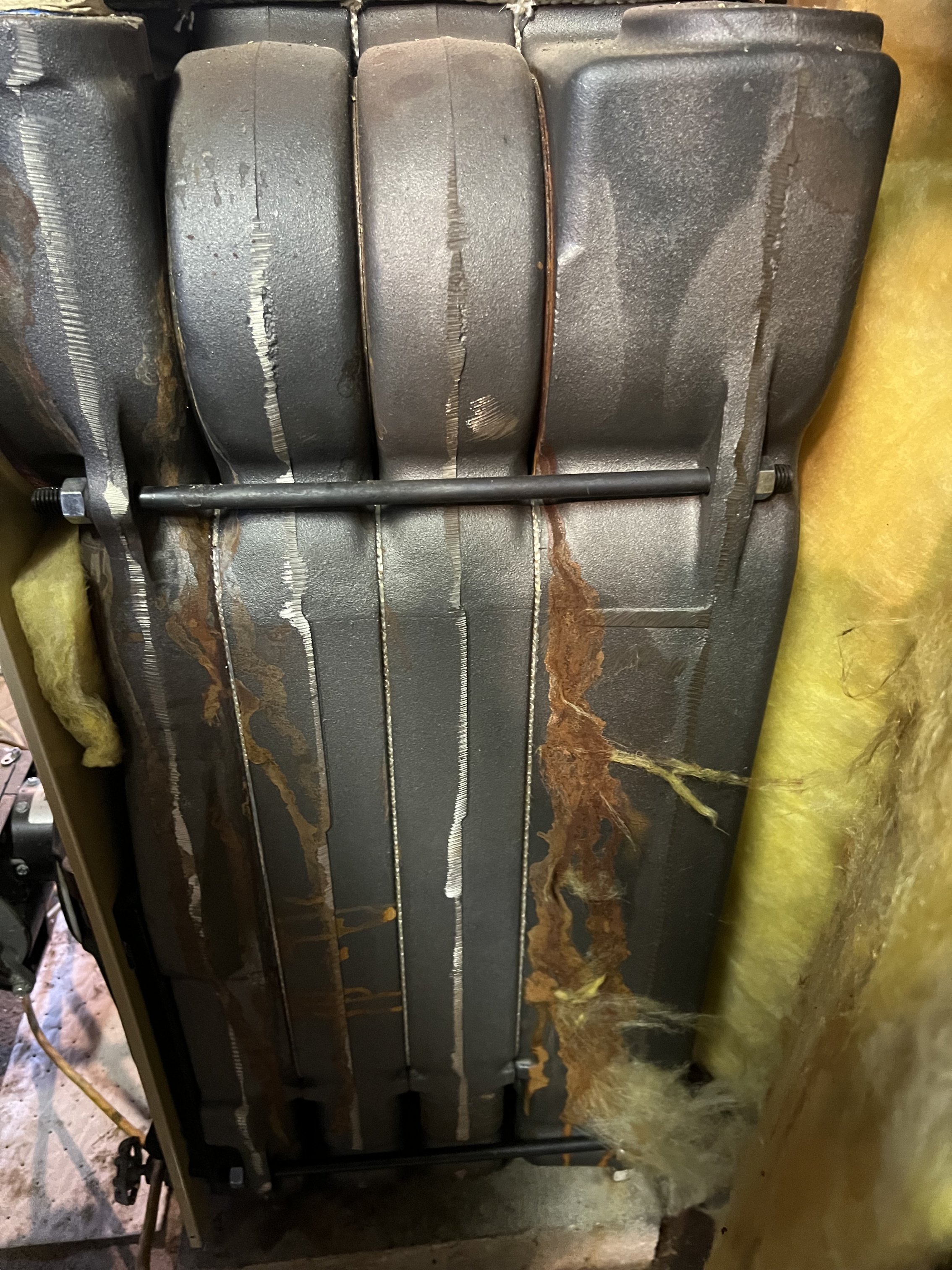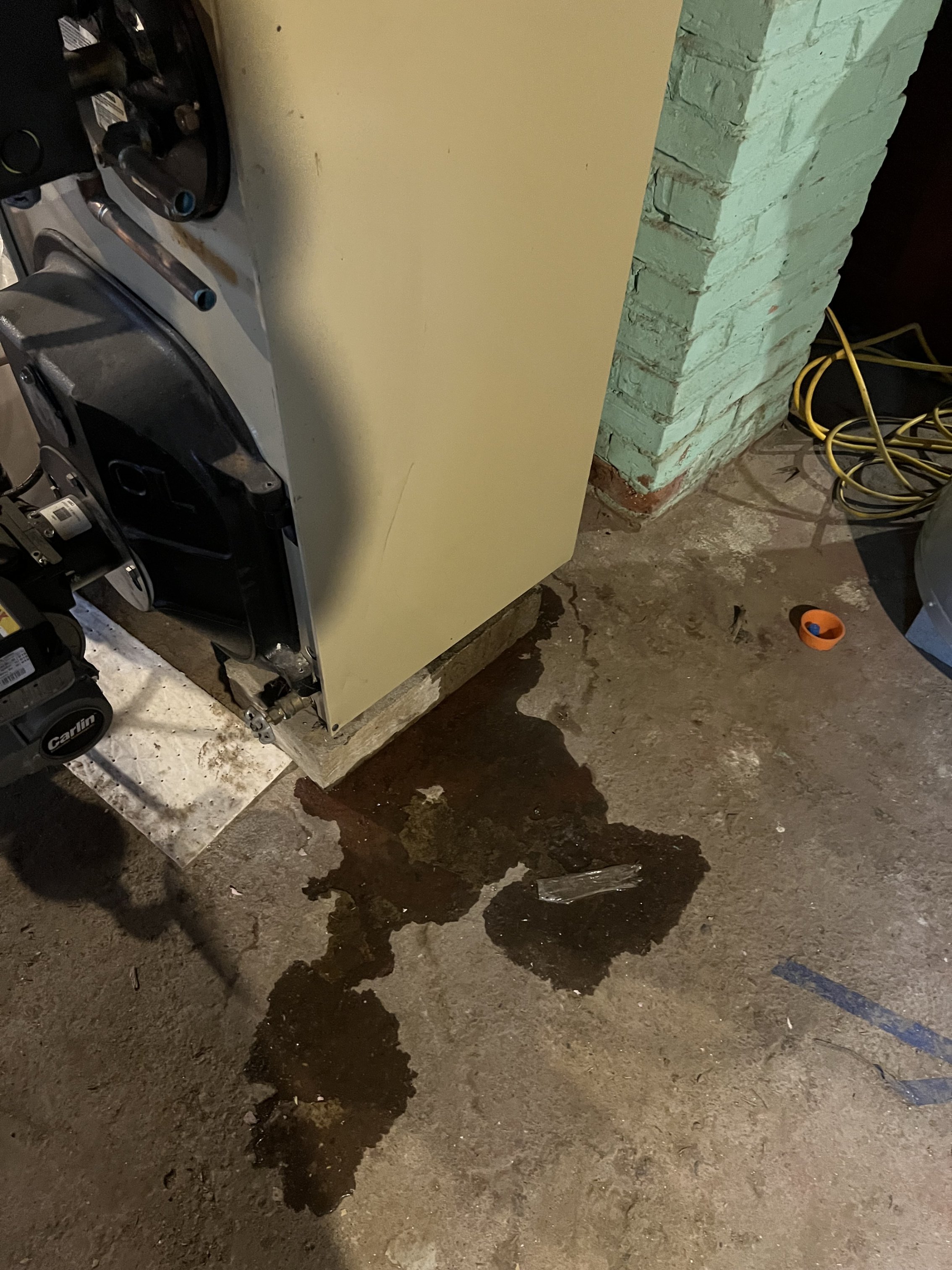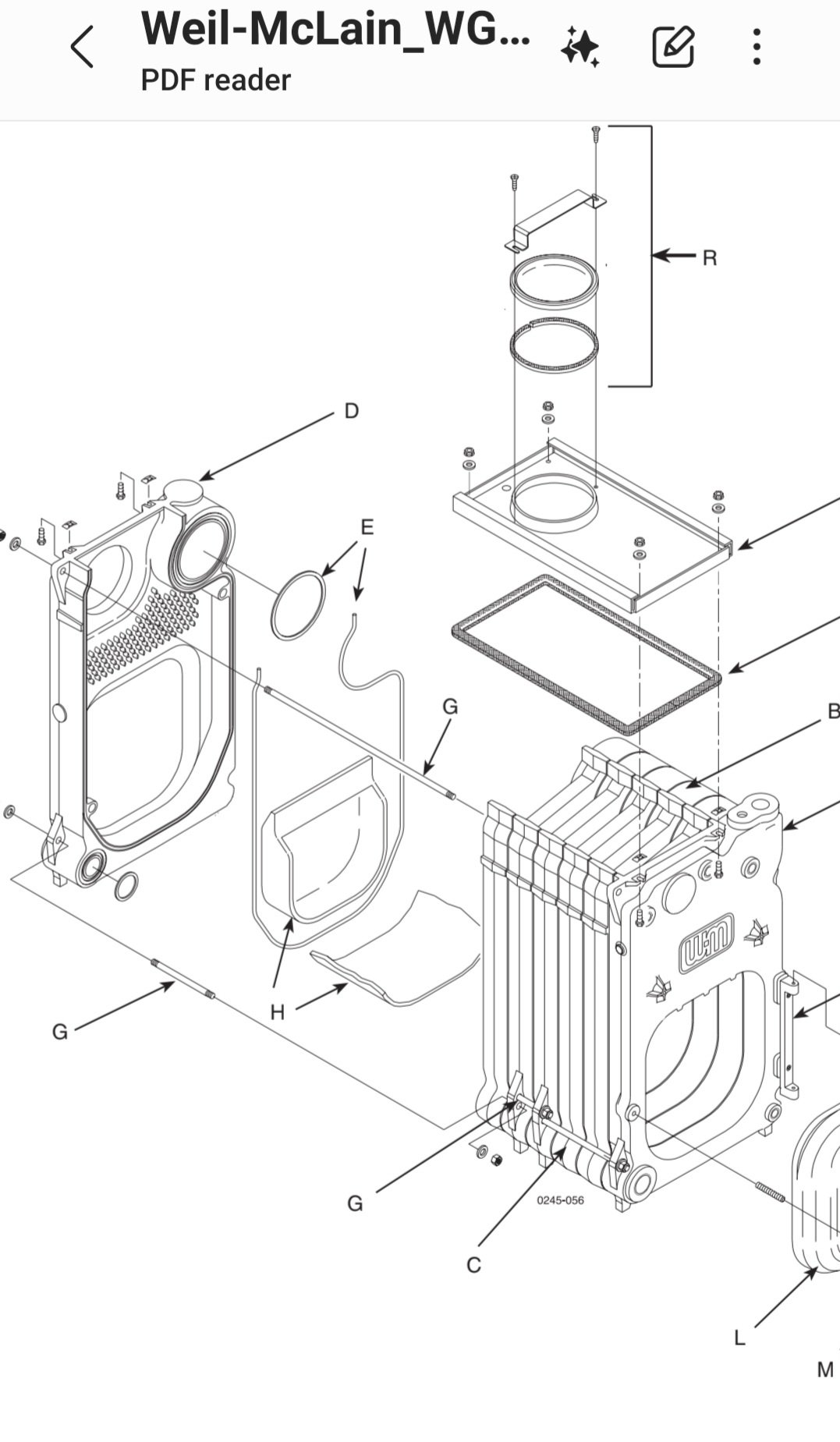Warm Start Boiler Summer Leak
Installed an electric hot water heater last fall to replace the tankless on demand hot water off my oil boiler (couldn’t quite keep up with hot water during winter months) and my electric rates are very cheap. I had a service tech come out to do a yearly cleaning and said everything looked good and he lowered my low limit setting a bit because I didn’t need the hot water production anymore.
Boiler ran all winter but in March or April I noticed the floor behind the boiler looked wet/boiler was leaking - just when the boiler wasn’t running as often. Pulled the jacket off to see where it was coming from (attached picture) and appears to be in between one of the sections.
I also checked the low limit set point and it was down to 90 - I turned it back up to about 130 and the boiler hasn’t leaked since. crossed fingers
Is this boiler toast even though the leak has stopped the last 3/4 months? It’s not even 10years old yet - Weil McLain Gold forced hot water system.
Thanks for any insight!
Comments
-
Sounds like a leak at a mating surface; not enough gasket material or an imperfection in the cast iron.
I’d keep the temperature at 130F and cross your fingers.8.33 lbs./gal. x 60 min./hr. x 20°ΔT = 10,000 BTU's/hour
Two btu per sq ft for degree difference for a slab0 -
Thanks! Sounds like that could be a factory defect? As I mentioned it’s less than 10 years old - factory inspection sticker is dated Dec 2015 so might have some warranty left.
0 -
-
Shut the boiler off completely and see if there is still a leak. That will eliminate the flue gas condensation issue. If it still has water on the floor after a week of being off then…
There are three possibilities.
- You have a leaking boiler and the higher temperature stops the leak when the metal expands to 130°. You just need to spend more on fuel
- You have a leaking boiler that can be repaired by torquing up on the connecting rods when the boiler is cold. If that stops the leak, then you can make it a cold start boiler. 90° is not such a good idea, wastes less fuel but may cause condensation of flue gas.
- You have a leaking boiler and you can get a warranty replacement block on the ten year old boiler for free. Weil McLain will not pay for the labor to remove the leaking boiler or to install the replacement boiler.
Edward Young Retired
After you make that expensive repair and you still have the same problem, What will you check next?
2 -
Yes it fires - it’s ran in short spurts when I was testing it a bit and has been maintaining around 130degrees the last 3 or 4 months since I set it there. No water on the ground since knock on wood
Picture of found puddle when it was still set at 90
0 -
Of the various options @EdTheHeaterMan listed, I'll pick number two. Mostly since if you keep it warm it doesn't seem to leak. Weil-McClain boilers are very much dependent on correct assembly, and there is a very clear torque specification for the tie rods. It's in the manual. I don't have one handy, but maybe someone has it — and just maybe you do, somewhere in the basement. You should.
It's not uncommon for them to not be torqued adequately, which will lead to leaks when cold. If caught soon enough simply retorquing to spec. may cure the problem.
Br. Jamie, osb
Building superintendent/caretaker, 7200 sq. ft. historic house museum with dependencies in New England2 -
the rubber gaskets over time get used to the temp they are working at and as they age, they lose resiliency. You upped the temp, and it stopped leaking.
If you can get a new block under warranty that is a good deal. If you can continue to use the old block and get the new one that is a better deal. I doubt they want it back but they probably have some type of verification system but I would look into that.
Chances are at 130 you will run that block for quite a while
1 -
-
I’ll have to take a look if there’s a user’s manual left behind - I wasn’t the homeowner during the initial install so hoping something got left behind.
I dd put a crescent wrench on each end of the tie rod to see if either side was glaringly loose and both seemed tight - didn’t want to crack anything though so very minimal force.
0 -
the manual should be on weil's web site
0 -
As mentioned above, tightening the connecting rods is a very good idea. Removing the section(s) can be a painstaking and laborious process. Especially if doing it alone. Raise the temperature first and leave it up. That should cure the leak.
0 -
Gaskets for the coil section are the culprit.
There might be a prorated warranty, but the labor is out of pocket.
0 -
what type of hear emitters do you have? Cast iron radiators of fintube baseboard?
You may need to bump the temperature up to more like 150 minimum. The temperature control has a differential, at 130 shutoff it may drop to 110 or lower before it fired, it may condense “sweat” at low temperatures
It should not run more than 10 minutes below 130 when the heat is on
Bob "hot rod" Rohr
trainer for Caleffi NA
Living the hydronic dream0 -
I'm hoping it isn't one of the gaskets, @HVACNUT — although that is a problem I have seen happen. Usually would show up sooner, though. The problem isn't so much that they lose resiliency, though they can — but those gaskets have a square cross section, not round, and it is possible to get a twist in them when installing. Then they will indeed leak, and fairly soon.
Br. Jamie, osb
Building superintendent/caretaker, 7200 sq. ft. historic house museum with dependencies in New England0 -
A couple of observations.
The warranty for your year boiler does not seem to be pro rated. So anytime between now and 2034 should be fine to get new boiler under warranty. But I would not wait until then. You can keep the new block in storage until you thing the leak is beyond control.
The photo of the rest on the side of the block and the photo of the water under the boiler are sufficient for the warranty claim
After 2 years the old block need not be returned to the factory. From my experience, 'field scrap" is the normal warranty procedure after 3 years in service.
Edward Young Retired
After you make that expensive repair and you still have the same problem, What will you check next?
0 -
Based on the pictures I doubt it is cracked. My guess is the upper port gasket is where the leak is and it is running down.
0 -
Still the upper port gasket leak qualifies as a leaking boiler and Weil McLain will usually honor that when it is brought to their attention via a warranty claim. The worst that can happen is the warranty folks at WM say no. Then you appeal and they say no again. But I remember when I did WM warranty claims, I could talk them into covering that exact situation. The warranty coverage uses the term "heat exchanger" not "boiler section" on the WGO, WTGO and SGO warranty form. See copy of warranty form here Weil McLain WTGO 20 Year Warranty
Edward Young Retired
After you make that expensive repair and you still have the same problem, What will you check next?
1 -
-
Thanks for all the help/info!
For reference I am running forced hot water on some big cast radiators.
I’m not a plumber or heating system pro but have a few friends that are - hoping they can look in to the warranty claim/submittal. Based on the info online it looks fairly straight forward.
Appreciate the advice!
0 -
does it have a way to protect he boiler from low return water temps?
0 -
I would guess not. Since this is a WTGO boiler it was equipped with a tankless coil, that would mean to offer DHW priority the circulator would stop pumping cold radiator water when the aquastat reached the low limit circulator cut out temperature. The boiler would always maintain 140° or more if the low limit was set at 160° with a 20° diff. No need for boiler protection in this case.
Now that the cold start boiler is an option, they may need to think about boiler protection with a bypass of some sort, or some reverse strap on aquastat that keeps the circulator from operating when the supply temperature is below say 150°. the circulator would cycle several times as a result, but it did that when it was operating for DHW anyway. So no big deal.
Edward Young Retired
After you make that expensive repair and you still have the same problem, What will you check next?
2 -
that is a form of protection
0
Categories
- All Categories
- 87.4K THE MAIN WALL
- 3.2K A-C, Heat Pumps & Refrigeration
- 61 Biomass
- 429 Carbon Monoxide Awareness
- 120 Chimneys & Flues
- 2.1K Domestic Hot Water
- 5.8K Gas Heating
- 115 Geothermal
- 168 Indoor-Air Quality
- 3.7K Oil Heating
- 77 Pipe Deterioration
- 1K Plumbing
- 6.5K Radiant Heating
- 395 Solar
- 15.7K Strictly Steam
- 3.4K Thermostats and Controls
- 56 Water Quality
- 51 Industry Classes
- 50 Job Opportunities
- 18 Recall Announcements









